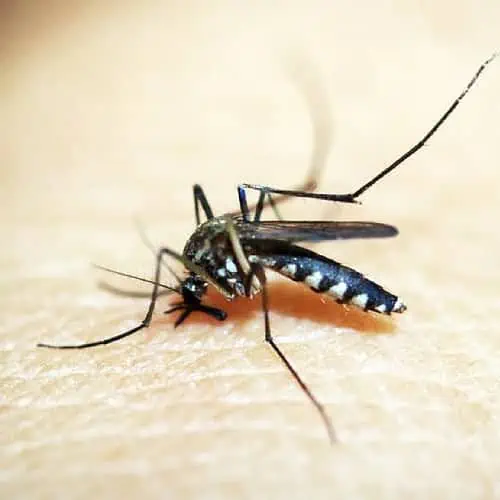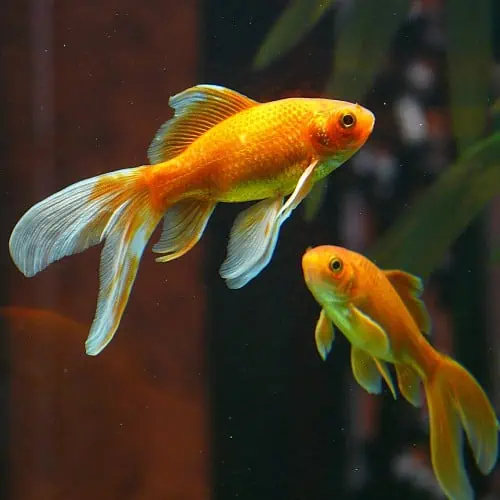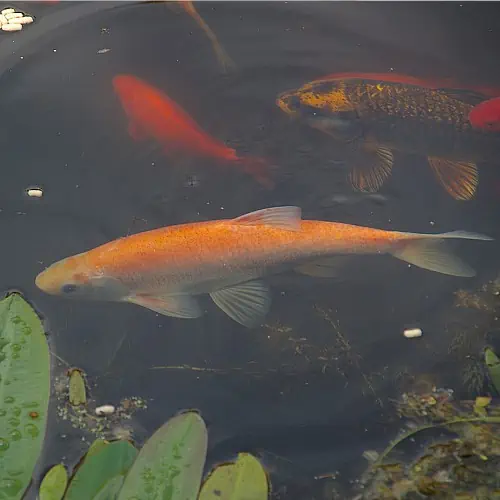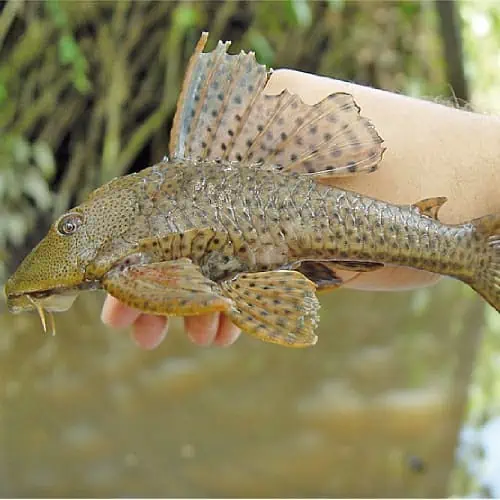
Mosquitoes. The very mention of them likely makes you scowl, and rightly so. With their blood-sucking attitude and tendency for spreading diseases such as malaria, yellow fever, and West Nile virus (not to mention those horrendously itchy bumps that their bites produce!), you likely don’t need much convincing to keep mosquitoes out of your pond.
There are already over 3,500 subspecies of mosquitoes worldwide, and scientists have found that they are currently in the process of splitting into several subfamilies as well, meaning that control methods that work for one variety may not work for another. In addition, utilizing pesticides can have some nasty adverse impacts like running off into any nearby water sources, building up in gardens and crops, and causing skin and lung damage, among other things. Certainly not something you want to use on your garden pond.
So is there a control method that works just as well for all mosquito types and is all natural? Yes, simply by using your pond fish! Here we will discuss a few species of pond fish that consume mosquito larvae and help keep these vampiric pests at bay!
1) Goldfish (Carassius auratus)

While most goldfish will readily eat mosquito larvae, comets and shubunkins have a darker coloration that enables them to better blend in with their surroundings. This means that they have a higher likelihood of ingesting more mosquito larvae than brightly colored goldfish varieties. Both of these goldfish varieties are fairly large (13 to 16 inches in length), quite hardy and easy to take care of, and are suitable for both veteran and beginner backyard pond enthusiasts.
Another factor to keep in mind is the size of your goldfish – smaller goldfish are better able to adeptly maneuver about the pond, particularly if your pond has lots of plants and other obstacles that double as hiding places for larvae.
2) Koi Carp (Cyprinus carpio)

As koi are large (up to 3 feet long), they are not as well-adapted to eating small mosquito larvae and will not actively seek them out. However, they will eat the larvae if they happen across them. If you’re providing supplemental feedings for you koi, they’re less likely to eat mosquito larvae and other aquatic pests as their appetite will already be sated. Try feeding them a bit less and they’ll begin feeding on the natural food options already present in your pond, like larvae.
Your best bet with koi is to include other mosquito-eating fish species as well, particularly larger goldfish or orfe as these species get along well together. Koi may consume smaller fish species like mosquito fish and minnows, so keep that in mind as well.
3) Guppies (Poecilia reticulata)

A typical guppy is capable of eating nearly their body weight in mosquito larvae daily. Due to their very small (only up to 2.5 inch-long) size, they can easily zip about the pond and find larvae in even the most obscure areas. They reproduce swiftly, and within six months you can go from a handful of guppies to thousands of mosquito-devouring machines. You may not mind this, as these little tropical fish are quite beautiful and colorful, though if their population does become an issue most pet stores will purchase them from you.
Otherwise, if you live in a seasonal area the guppies will naturally die out once the water temperature falls below approximately 55°F, or you can incorporate other fish that will eat them.

4) Mosquito Fish (Gambusia affinis)
Perhaps the most efficient and voracious mosquito-eating species, a single mosquito fish can eat 100 to 500 mosquito larvae in a single day! They will also happily eat water beetles, mayfly and caddisfly larvae, and other aquatic invertebrates that may otherwise become nuisances in your pond.
However, these small 1.5 to 3 inch long fish multiply very quickly – this is great for keeping mosquitoes and other pests under control, but could overload your pond if left unchecked. When getting rid of excess mosquito fish, be sure to take them to a pet store or breeding facility as many of them will accept these helpful fish. Simply releasing them into the wild could wreak havoc on natural ecosystems as they breed rapidly and may out-compete other natural fish species. In addition, in some areas (such as Washington and Michigan in the U.S., for example) mosquito fish are an invasive species that the US Fish and Wildlife Service is actively trying to control and eliminate from natural water bodies as they are taking over some areas. Alternatively, if you have a separate pond with turtles and frogs, they will gladly eat any surplus mosquito fish. Because of their small size, you’ll want to be sure to have only fish of a similar size (such as small goldfish breeds that will also eat mosquitoes) with them or provide plenty of hiding places, as larger species often prey on mosquito fish.
5) Golden Orfe (Leuciscus idus)

The orfe, or ide, is a beautiful, bright golden-orange fish that loves preying on aquatic pests, including water beetles and mosquito larvae. As adults, they have even been known to jump out of the water and catch adult flying mosquitoes. Orfe are large, growing up to 20 inches in length, and are a social fish, preferring to swim about in small schools. Since they’re large and considered predatory, it is wise to not include smaller fish in the pond with them, as they may eat them if they’re hungry.
However, golden orfes are easygoing, non-aggressive hardy fish that can be kept with koi and larger varieties of goldfish without issue! Having a combination of these three fish species would certainly put a dent in mosquito populations with minimal effort on your end. Orfe don’t breed often and usually only a couple of the babies actually survive to adulthood, so you won’t have to worry about their populations growing out of control.
6) Minnows (Phoxinus phoxinus)

Minnows feed heavily on mosquito larvae and reproduce quickly, meaning they can really put a dent in mosquito populations. Aquatic insect larvae and detritus floating about your pond make up the majority of their diet. However, you’ll need to restock these fish (probably annually) as any larger fish present in your pond, such as goldfish and koi, may eat the minnows if they’re hungry enough. Luckily, minnows are cheap and there are many varieties to choose from!
The University of Wisconsin conducted a study in 2009 examining fathead minnows as a natural, biological control option for mosquito populations, and found the minnows to be a better long-term solution that are also more ecologically and economically friendly than chemical options. Because so many other fish species prey on minnows, there is little concern of them overpopulating ponds or natural aquatic systems.
7) Common Pleco (Hypostomus plecostomus)

Plecostomus, or simply the common pleco, is a South American native bottom-dwelling sucker catfish that can grow up to two feet and will eat just about anything, from zucchini to dead fish to algae. While typically valued for their algae consumption (just one can eat all of the string algae per 1,000 gallons of water), plecostomus will also consume mosquito larvae, though not in as large of quantities as some other species. They’re a nice last-line-of-defense as they will eat anything that your other fish miss or leave behind.
They get along with most other fish species, but prefer to be the only one of their kind, so be sure to have only one unless you have a large pond where they won’t need to compete for food and space.
Conclusion – Which Fish Should I Choose For Larvae Control?

This really depends on your personal preferences and your pond itself. As mentioned in previous articles, different fish have different requirements, from pH and temperature to pond depth and size. Ultimately, always do your research before choosing which species to stock your pond with. Generally speaking, it is best to keep similarly-sized fish species together to minimize predation. If you have a large pond, a combination of koi, sizeable goldfish species, and golden orfe would work well together as they are of a similar size, have similar pond requirements, and typically get along well together. Koi do not eat a large amount of mosquito larvae, so combining them with these other fish species would ensure you keep pest numbers under control. You could also utilize a plecostomus at the bottom of your tank that will peacefully take care of any algae or insect larvae left behind by your other fish. Only use these species if you have a pond that is at least a meter deep with a minimum of 1,000 gallons per every four fish. These larger species are also better suited to being able to withstand seasonal temperature fluctuations, and do not breed as quickly as many smaller fish species.
However, smaller fish are much more likely to eat the tiny mosquito larvae as a part of their natural diet. With this in mind, if you have a definite mosquito population, have a smaller pond (or a smaller budget), incorporating a mixture of goldfish, mosquito fish, minnows, and guppies will certainly take care of any mosquito larvae. However, bear in mind that mosquito fish and minnows can tolerate a wide temperature range (34-104°F and 41-72°F, respectively), while guppies are more sensitive and require more temperate waters between 70-80°F. Mosquito fish are also considered an invasive species in many areas, so you’ll have to be certain that, one: they are legal to have where you live; and two: your pond is not near a natural waterway that they could escape into. Truly, mosquito fish are only recommended if you really have a significant mosquito problem.
Goldfish of all varieties will eagerly consume larvae, and because of the large range of goldfish types that are available, you can easily find a species (or multiple species) that will work well with your budget, climate, experience level, other fish species present in your pond, and pond size. Guppies are also cheap, easy to take care of, don’t require a large pond, and are fairly tolerant of temperature and pH fluctuations.


This article is very helpful for a part of our Thesis. We are proposing a 31.5″ wide pond surrounding a monument. Which of these fishes can be together in that particular pond? And what plants and wildlife species can also be part of that pond as a filter?
Many Thanks! 🙂
which fish is better I also have ducks and turtle in my pond
thankyou
Hi Barbara,
Do you know what species of turtle you have? Also, how large is your pond and where roughly are you located (climate, avg temps etc.)?
Which fish is better for my red eared slider turtle tank. I live in a tropical climate country and i put my tank outside.
Hi Norman,
How many gallons is your tank? Also, what are the average daily and nightly temperatures?
PLECOSTOMUS > “They get along with most other fish species. . . ”
You make reference to ponds containing Koi, Goldfish, etc. but I would like to know if putting one plecostomus in a 29-gallon indoor tank with common goldfish would be safe.
Hi Ralph,
Most plecos, in general, are considered very peaceful species and will get on with most types of non-aggressive fish, including goldfish. The more important question here is if the 29 gallon tank is enough for both of these fish species, as depending on which type of catfish you purchase, they can grow VERY large indeed! More info here: https://pondinformer.com/cold-water-pleco-pond-guide/
Plecos live long and prosper, I mean grow.
I have a kiddie pool that tadpoles have made their home. However, these little guys are becoming frogs and not really eating the mosquito larva. So I’m wondering what fish will not eat my tadpoles/frogs? Any suggestions would be greatly appreciated
Hi Sherrie,
Mosquito fish seem the ideal choice here, as they’re usually a little too small to hunt tadpoles but LOVE hunting all kinds of smaller larvae, including that of mosquitoes.
Just to confirm though, is this pool going to become a more permanent ‘pond’ moving forward? The reason I ask is because frogs can obviously leave the pool or you can easily relocate them if you decide to remove it, but fish have no where to go. If you intend to keep this as a pond long-term, mosquito fish would indeed be good pick, but if this is just for the summer, I’d actually advise against adding fish in general.
But will eat the mosquito larva.
I hit post comment button way to early lol
Hi,
I currently have a 5000 gallon gold fish pond, a 18000 gallon adult koi fish pond with waterfall and a 180000 gallon koi fish pond with 46 large koi fish and 215 baby koi. I need to know if you can recommend a way to control the mosquito population best for my ponds.
Thank you
We have a pond in southern Delaware, that leads to a creek into leads into the bay (empties leads in the Atlantic Ocean). What are good fishes that will: 1. eat mosquitos and mosquito larva, 2. survive during cold winters, 3. not multiple excessively. TIA!
Hi George,
Is there any way for the fish to escape the pond into the creek? If so, we wouldn’t recommend adding any fish until they absolutely cannot escape into the natural waterways.
If that’s not an issue, my next question is: do you heat or partially de-ice your pond in the winter? If your pond totally freezes, you’ll at least need to have a deicer present to ensure gas exchange still takes place for the fish.
1. Koi do well in temperatures as low as in the 50’s. They’ll eat some mosquito larvae but not a ton, though as mentioned in the article they’ll eat more if you lessen supplemental feeding. They’re tricky to breed, so overmultiplying shouldn’t be an issue.
2. Golden orfes do very well in water temperatures between 50 and 77 degrees, plus they eat loads of mosquito larvae AND they don’t breed often! They’re very active, though, and have been known to jump rather high so you’ll have to be certain to have measures in place to keep them from getting into the creek.
3. Weather loaches are very tolerant of cold temperatures and do well in waters between 40 and 77 degrees. They won’t eat a massive amount of mosquito larvae, but their natural diet does consist of insect larvae, algae, and just about anything else (they’re not picky eaters at all!). They also don’t breed quickly or often.
4. Guppies can eat just about their bodyweight in mosquito and insect larvae daily, and do well in water temps as low as 50 degrees. They can breed on a monthly basis, though.
5. You may consider non-ornamental and native species, like bluegill and bass. These are well-adapted to cold conditions, don’t multiple overly quickly, and are fantastic at keeping larvae numbers under control.
If you want, you can use a combination of all of the above species depending on your water quality parameters! Koi and bass will likely eat some of the guppies, which could be a boon in helping to control their numbers.
I hope that this helps!
The obvious solution here is to get a bait fishing net and use it to catch native minnows in the creek (after checking your state’s fishing regulations). Nearly any small fish will eat mosquito larvae. Using native fish resolves the invasiveness and climatic issues.
Hi Mike,
That is a great suggestion! Thank you for posting it.
Plecostomus or pleco is a great algae-eater. They don’t bother or eat anything but algaes. They do like shade and hide when not eating. Do research the types and sizes to get the right one or more for your aquarium or pond. Whiskered ones only grow to 3-5 inches, and some others grow too big for aquariums. No matter the size they are not aggressive. Although some males like to constantly mate with multiple females.
I have this one pond back in my hayfield and it’s a pretty big pond it’s not too big but not too small and I always go swimming in it well those little red worms the blood worms always get everywhere and I do have frogs back there but they don’t seem to be eating them and there’s so many of them what type of fish will be best for that.